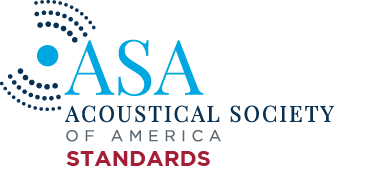We’re delighted to announce this new set of newly reaffirmed (2023) ASA Standards:
ASA/ANSI S1.18-2018 (R2023)
Method for Determining the Acoustic Impedance of Ground Surfaces
Abstract:
This Standard describes procedures for obtaining the real and imaginary parts of the normalized acoustic impedance ratio of ground surfaces from in-situ measurements of the sound pressure levels at two vertically separated microphones using specified geometries and the averaged values of the difference between the simultaneous, instantaneous sound-pressure signals at the two microphones. It enables the user to either deduce parameters for a ground impedance model by fitting spectral data to templates or obtain values of the normalized specific acoustic impedance ratio of the ground entirely from measurements and independently of any model for the acoustic impedance of the ground surface except as a check on the validity of the resulting values.
ASA/ANSI S2.72-2002/Part 1 / ISO 2631-1:1997 (formerly ANSI S3.18-2002 / ISO 2631-1:2001)(R2023)
Mechanical vibration and shock – Evaluation of human exposure to whole-body vibration – Part 1: General requirements
Abstract:
This part of ANSI S2.72 / ISO 2631 defines methods for the measurement of periodic, random and transient whole-body vibration. It indicates the principal factors that combine to determine the degree to which a vibration exposure will be acceptable. Informative annexes indicate current opinion and provide guidance on the possible effects of vibration on health, comfort and perception and motion sickness. The frequency range considered is 0.5 Hz to 80 Hz for health, comfort and perception and 0.1 Hz to 0.5 Hz for motion sickness. Although the potential effects on human performance are not covered, most of the guidance on wholebody vibration measurement also applies to this area. This part of ANSI S2.72 / ISO 2631 also defines the principles of preferred methods of mounting transducers for determining human exposure. It does not apply to the evaluation of extreme-magnitude single shocks such as occur in vehicle accidents. This part of ANSI S2.72 / ISO 2631 is applicable to motions transmitted to the human body as a whole through the supporting surfaces: the feet of a standing person, the buttocks, back and feet of a seated person or the supporting area of a recumbent person. This type of vibration is found in vehicles, in machinery, in buildings and in the vicinity of working machinery.
ASA/ANSI S2.72/Part 1 Amd. 1-2010 / ISO 2631-1 Amd. 1:2010 (R2023)
Mechanical vibration and shock – Evaluation of human exposure to whole-body vibration – Part 1: General requirements, AMENDMENT 1
Abstract:
This amendment to ANSI S2.72-2002/Part 1 / ISO 2631-1:1997 provides numerous updates and corrections throughout the document.
ASA/ANSI S3.46-2013 (Revision of ANSI S3.46-1997)(R2023)
Methods of Measurement of Real-Ear Performance Characteristics of Hearing Aids
Abstract:
This Standard provides definitions for terms used in the measurement of real-ear performance characteristics of hearing aids, provides procedural and reporting guidelines, and identifies essential characteristics to be reported by the manufacturer of equipment used for this purpose. Acceptable tolerances for the control and measurement of sound pressure levels are indicated. Where possible, sources of error have been identified and suggestions provided for their management.
ASA/ANSI S12.11-2013/Part 1 / ISO 10302-1:2011 (R2023)
Acoustics – Measurement of airborne noise emitted and structure-borne vibration induced by small air-moving devices – Part 1: Airborne noise measurement
Abstract:
ANSI/ASA S12.11‐2013/Part 1 / ISO 10302‐1:2011 specifies methods for measuring the airborne noise emitted by small air‐moving devices (AMDs), such as those used for cooling electronic, electrical, and mechanical equipment where the sound power level of the AMD is of interest. Examples of these AMDs include propeller fans, tube‐axial fans, vane‐axial fans, centrifugal fans, motorized impellers, and their variations. This part of this American National Standard describes the test apparatus and methods for determining the airborne noise emitted by small AMDs as a function of the volume flow rate and the fan static pressure developed by the AMD on the test apparatus. It is intended for use by AMD manufacturers, by manufacturers who use AMDs for cooling electronic equipment and similar applications, and by testing laboratories. It provides a method for AMD manufacturers, equipment manufacturers and testing laboratories to obtain comparable results. Results of measurements made in accordance with this part of this American National Standard are expected to be used for engineering information and performance verification, and the methods can be cited in purchase specifications and contracts between buyers and sellers. The ultimate purpose of the measurements is to provide data to assist the designers of electronic, electrical or mechanical equipment which contains one or more AMDs. Based on experimental data, a method is given for calculating the maximum volume flow rate of the scaled plenum up to which this part of this American National Standard is applicable.
ASA/ANSI S12.11-2013/Part 2/ ISO 10302-2:2011 (R2023)
Acoustics – Measurement of airborne noise emitted and structure-borne vibration induced by small air-moving devices – Part 2: Structure-borne vibration measurements
Abstract:
ANSI/ASA S12.11-2013/Part 2 / ISO 10302-2:2011 covers vibration levels from small air-moving devices (AMDs) with mounting footprints of less than 0.48 m × 0.90 m for the full-size test plenum defined in ANSI/ASA S12.11/Part 1 / ISO 10302-1 and less than 0.18 m × 0.3 m for the half-size plenum. It covers all types of AMDs which can be mounted on, and are self-supported at, the discharge or inlet plane of a test plenum box as specified in ANSI/ASA S12.11-2013/Part 1 / ISO 10302-1:2011. The procedures defined in this part of this American National Standard specify methods for determining the vibration levels that a small AMD would induce in an average structure used in information technology and telecommunications equipment. The methods specified in this part of this American National Standard allow the determination of induced vibration levels for the individual AMD that is tested. These data can be used to determine the statistical values of vibration levels for a production series if levels are measured for several units of that series.

0 Comments